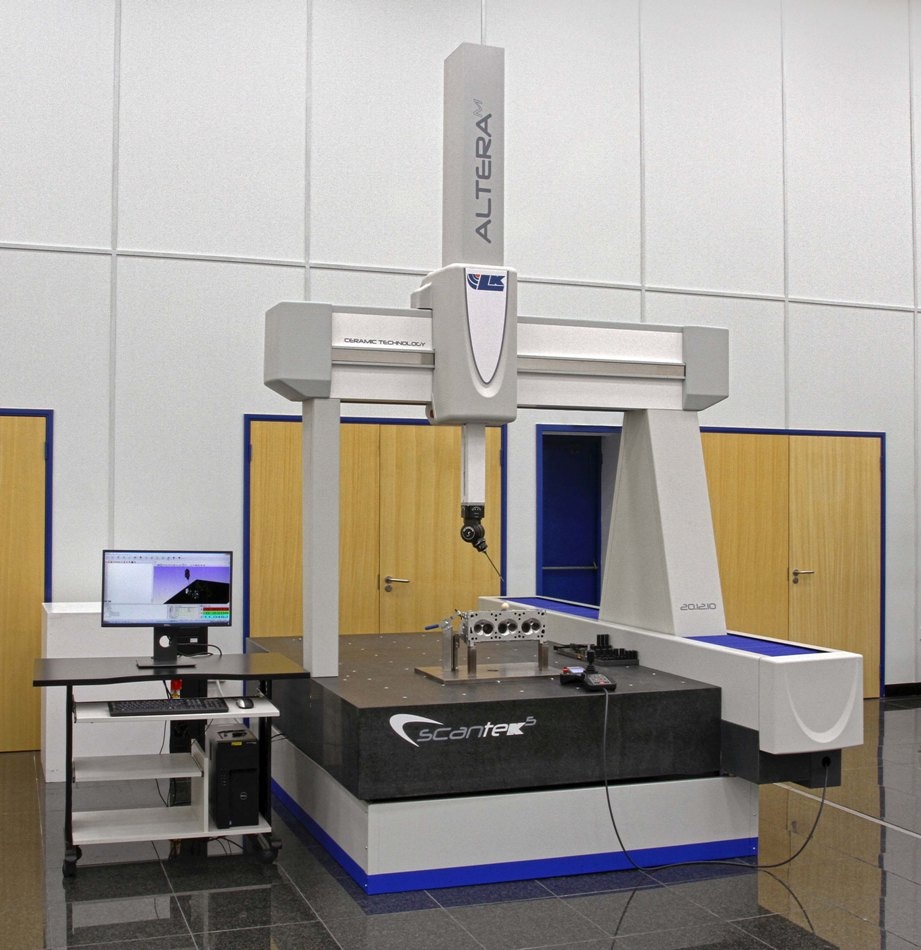Flexible, multi-sensor probe system for tactile scanning, non-contact inspection and surface finish measurement on a 5-axis, ceramic-bridge CMM provides enduring performance across all manufacturing environments.

Built in Castle Donnington, Derbyshire by LK Metrology, the high precision ALTERA range of coordinate measuring machines (CMMs) has been coupled with Renishaw's REVO-2 scanning system and multi-sensor technology to offer manufacturers a powerful 5-axis solution for inspecting the dimensional accuracy and surface finish of components. A notable design feature is the ceramic construction of the CMM beam and spindle, which combines optimal stiffness-to-weight ratio for exceptional responsiveness with mechanical and thermal stability for consistent performance across all manufacturing environments.
Offering unprecedented measuring speed, the SCANtek 5 multi-sensor package includes Renishaw's proven, intuitive MODUS software for importing data, controlling the CMM, acquiring results and reporting, including GD&T (geometric dimensioning and tolerancing) labelling. The machine's high scanning speed boosts measurement throughput, shortens production lead-times, provides a comprehensive awareness of product conformance, and prevents the metrology department from becoming the bottleneck in a factory.
SCANtek 5 is available with a variety of standard measuring volumes from 800 x 700 x 600 mm (8.7.6) to 6,000 x 2,000 x 1,000 mm (60.20.10), with larger options. The ALTERAM models with repeatability from 1.5 µm are being marketed alongside an ALTERASL range offering repeatability from 0.7 µm. LK is so sure of the long-term performance of all these premium machines that it is the only CMM manufacturer to offer a 10-year accuracy guarantee.
Ready for operation immediately it arrives in the inspection room or on the shop floor, the 5-axis CMM gives users a competitive advantage, making it easier to win new work and helping to bring products to market faster. A 3-axis measuring solution, by contrast, is often unable to measure some complex features. In any case, it requires constant acceleration and deceleration of large moving elements of the CMM, whereas the rotations of the REVO-2 head are synchronised with constant velocity machine motions when scanning, allowing changes in component geometry to be followed without introducing dynamic errors.
Scanning at up to 500 mm/s, without the stylus leaving the surface of the component, allows the coordinates of up to 4,000 points to be captured 'on-the-fly' every second, a rate of data acquisition far higher than is possible using conventional probing techniques. It is also possible to include rapid, single-touch routines into a measuring cycle. Moreover, the flexibility offered by infinite head positioning increases the effective measuring volume by minimising the need for head reorientations, while allowing highly complex measuring. Exchanging the REVO-2 scanning probe for one of the vision modules increases data collection rates further and the results can be correlated accurately with those acquired using tactile methods.
By employing different tip arrangements and knuckle joints, detailed surface finish analyses can be combined with other CMM measurements in a single operation, the basic output being Ra, RMS and raw data, with an extensive range of additions provided by standard and advanced surface texture options. Even fine bores down to 5 mm in diameter can be inspected. A variety of change racks up to one metre in length is available for housing sensors, probes and styli to enable automatic exchange during a measuring sequence.
The MODUS software with its user-configurable interface provides a powerful platform for creation of programs, either by teach mode or from a CAD model imported via the usual graphical exchange formats or directly from CATIA, Siemens NX, Parasolid, PTC Creo or Solidworks. Wizards in the Windows programming environment employing conversational, graphical and drag-and-drop methodologies give access to a range of macros and standard scanning routines such as helical, circular and sweep to ensure best practice metrology, without the need for specialist programming skills. The native DMIS (Dimensional Measuring Interface Standard) program with drawing geometry, dimensions and tolerance data embedded can be simulated offline to check for potential collisions before the inspection cycle is run on the SCANtek 5.
A wealth of textual and graphical reporting functionality is offered, including multi-part inspection for series production and real-time reporting during program execution. Data exchange to third party applications such as Excel, XML or SQL is provided, as well as to Q-DAS for statistical process control.
A SCANtek 5 is available in LK's Castle Donington technology centre for customer demonstrations. Two recently completed tests involved comparisons between 5-axis and 3-axis scanning of a cylinder head and an aero engine blisk. In the former automotive application, 12 valve seats and guides were inspected in 3 min 42 sec instead of 29 min 13 sec, an increase in throughput of nearly seven times. In the case of the blisk comprising 29 blades, nine sectional, eight longitudinal and two root profile scans per blade were completed, plus one annulus profile scan, in a total of 2 hrs 10.5 min, compared with 22 hrs 11 min using 3-axis scanning - a 922 per cent productivity improvement.